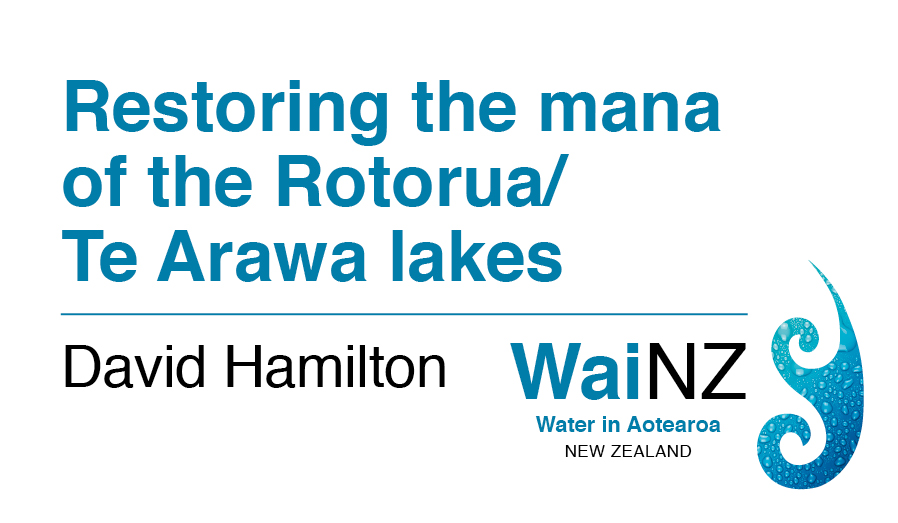Something interesting has been happening in the Rotorua/Te Arawa lakes over the past decade or so. Instead of separating into factious groups, government, NGOs, iwi, members of the farming community, scientists and the wider community have united in kōrero and actions to support restoration efforts on the lakes. Perhaps this is a model for Aotearoa to follow?
This whakarāmemene has been made possible by a number of interesting developments. Leaders such as Dr Ian Kusabs (Ngāti Tūwharetoa, Te Arawa, Ngāti Maru) have been researching and practicing mātauranga Māori and indigenous fisheries (kaimoana) management in the Rotorua/Te Arawa lakes in recent years. This work not only provides a means for iwi and hapū to exercise mātauranga but it is now being recognised as a scientifically defensible method to compliment conventional water quality indicators and better describe the health and wellbeing (i.e., the mauri) of the lakes. These types of models are desperately required for the goals of Te Mana o Te Wai to be exercised and achieved as part of the National Policy Statement for Freshwater Management (2017).
The community-led Lakes Water Quality Society has had a long history of involvement in protection and restoration of the Rotorua/Te Arawa lakes, through its own leaders, including Ian McLean and John Green. More recently, it has reached out to engage local kaumātua, for example Sir Toby Curtis, Willie Emery, Dr Ken Kennedy, Tai Eru and Geoff Rice. These kaumātua bring new perspectives akin to ‘ki uta ki tai’ and recognising that the restoration of the lakes is just the beginning with efforts that must extend across all rohe, from the top of the catchment to the receiving moana.
Farming groups in the Rotorua/Te Arawa lakes have adopted a highly science-based perspective in their own practices. They are cognisant that the lakes are tohu (indicators) of their own activities, with the mauri of the lakes reflecting the efficiency of their farming activities within the lake catchments. Farming leaders such as Chris Sutton, in the Lake Rerewhakaaitu catchment, have pushed through the initial resistance to change of farmers in this catchment. This farmer group is now starting to drive the regional management authority, Bay of Plenty Regional Council, to do things better; to implement well-informed plans and policies that allow them to simultaneously manage their business and be involved in lake management under a stable regulatory environment.
Regional and local governments have also engaged with the community more than ever before. They have had the benefit of a stable, evidence-based approach from science providers such as the University of Waikato, NIWA and GNS. Their own leaders, such as Andy Bruere from the Bay of Plenty Regional Council, have also recognised the importance of engagement with iwi and the local community, using hui to listen attentively to the needs and aspirations of iwi and hapū, as well as the local community. This is no longer consultation; this is full immersion and collective decision making.
Connecting these pillars for effective lake management will always be challenging, but the features of the Rotorua/Te Arawa Lakes Program need to be examined and propagated more widely. To provide a final perspective, we should examine the goals of the Rotorua/Te Arawa Lakes Strategy Group which was established between Rotorua District Council, Te Arawa Lakes Trust and the Bay of Plenty Regional Council to provide leadership for restoring the lakes:
Me huri whakamuri, Ka titiro whakamua
In order to plan for the future, we must look to the past
David Hamilton
About:
David Hamilton is the current Deputy Director of the Australian Rivers Institute, Griffith University, Brisbane. He served as the inaugural Bay of Plenty Regional Council Chair in Lake Restoration, University of Waikato, for 15 years (2002-2017) following 12 years at the Centre for Water Research, University of Western Australia, and PhD study on shallow lakes at the University of Otago. He has more than 250 publications in the area of lake restoration and biogeochemical processes in aquatic systems, and has provided research supervision to a large number of PhD, Masters and Honours students.
What is WaiNZ?
Kia ora, Aotearoa. We’ve asked leading environmental, social and health researchers to share their personal and professional perspectives about the state of our water and what water means to us as New Zealanders. Follow their blogs right here at tepunhahamatatini.ac.nz and across social media with #WaiNZ.
Where possible, commentary will be backed up by data from Figure.NZ. Their incredible charts are based on data sourced from public repositories, government departments, academics and corporations. Check out their #WaiNZ data board and sign-up to create your very own data board on any topic that interests you.

